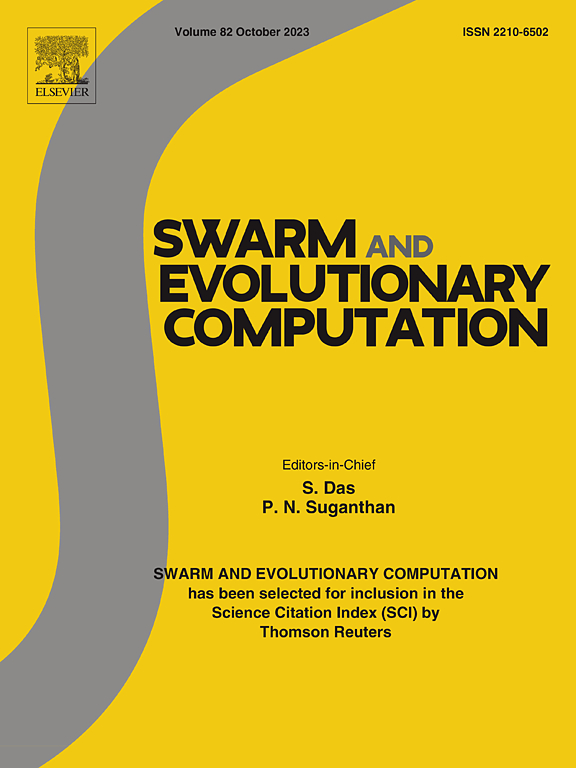合作搜索和覆盖的双层Voronoi策略
IF 8.2
1区 计算机科学
Q1 COMPUTER SCIENCE, ARTIFICIAL INTELLIGENCE
引用次数: 0
摘要
本文提出了一种基于voronoi的双层路径规划策略,以解决不确定环境下多智能体的协同搜索和覆盖问题。虽然传统的基于Voronoi的覆盖控制通常用于最优路径规划,但其局限性,如智能体过早收敛到Voronoi质心,导致探索减少和缺乏移动动机,可能会阻碍系统效率。所提出的双层策略提供了一个框架来克服这些限制,同时确保agent之间的环境分配更加平衡和适应性,从而提高环境平均不确定性降低和目标检测方面的整体性能。该框架利用基于代理位置的主Voronoi图进行初始空间划分。为了提高勘探效率,应用了二次Voronoi镶嵌,整合了目标存在的概率信息。双层框架通过采用有效的Voronoi分区分配,集成了智能体的位置和目标存在的概率,使智能体能够实现有目的的覆盖。为此,采用一种新的分配方法将Voronoi邻居分配给代理,确保每个代理区域内的公共单元分配给最值得分配的代理。这种机制促进了对不确定性减少的比例贡献,确保每个代理优先考虑更高不确定性或更大目标可能性的领域。通过这样做,agent高效地运行,有效地减少了环境的不确定性,提高了目标检测。仿真结果和对比分析验证了该策略的有效性,证明了该策略优于传统方法,在多智能体协作任务中具有重要意义。本文章由计算机程序翻译,如有差异,请以英文原文为准。
Bi-level Voronoi strategy for cooperative search and coverage
In this paper, a bi-level Voronoi-based path planning strategy is proposed to address the challenge of cooperative multi-agent search and coverage in uncertain environments. While traditional Voronoi-based coverage control is commonly utilized for optimal path planning, its limitations, such as agents' premature convergence to Voronoi centroids, leading to reduced exploration and lack of incentive to move, can hinder system efficiency. The proposed bi-level strategy provides a framework to overcome such limitations while ensuring a more balanced and adaptive allocation of the environment among agents, thereby enhancing overall performance in terms of environmental mean uncertainty reduction and target detection. This framework utilizes a primary Voronoi diagram based on agent positions for initial spatial partitioning. To enhance exploration efficiency, a secondary Voronoi tessellation is applied, integrating probabilistic information about the target’s existence. The bi-level framework enables agents to achieve purposeful coverage by employing an efficient Voronoi partition allocation that integrates both the agents' positions and the probability of target existence. To this end, a novel allocation approach is employed to assign Voronoi neighbors to agents, ensuring that common cells within each agent's region are allocated to the most deserved agent. This mechanism promotes proportional contributions to uncertainty reduction, ensuring that each agent prioritizes areas of higher uncertainty or greater target likelihood. By doing so, agents operate efficiently, effectively reducing environmental uncertainty and improving target detection. Simulation results and comparative analyses validate the proposed strategy, demonstrating its superiority over conventional methods and highlighting its significance in multi-agent cooperative missions.
求助全文
通过发布文献求助,成功后即可免费获取论文全文。
去求助
来源期刊

Swarm and Evolutionary Computation
COMPUTER SCIENCE, ARTIFICIAL INTELLIGENCEC-COMPUTER SCIENCE, THEORY & METHODS
CiteScore
16.00
自引率
12.00%
发文量
169
期刊介绍:
Swarm and Evolutionary Computation is a pioneering peer-reviewed journal focused on the latest research and advancements in nature-inspired intelligent computation using swarm and evolutionary algorithms. It covers theoretical, experimental, and practical aspects of these paradigms and their hybrids, promoting interdisciplinary research. The journal prioritizes the publication of high-quality, original articles that push the boundaries of evolutionary computation and swarm intelligence. Additionally, it welcomes survey papers on current topics and novel applications. Topics of interest include but are not limited to: Genetic Algorithms, and Genetic Programming, Evolution Strategies, and Evolutionary Programming, Differential Evolution, Artificial Immune Systems, Particle Swarms, Ant Colony, Bacterial Foraging, Artificial Bees, Fireflies Algorithm, Harmony Search, Artificial Life, Digital Organisms, Estimation of Distribution Algorithms, Stochastic Diffusion Search, Quantum Computing, Nano Computing, Membrane Computing, Human-centric Computing, Hybridization of Algorithms, Memetic Computing, Autonomic Computing, Self-organizing systems, Combinatorial, Discrete, Binary, Constrained, Multi-objective, Multi-modal, Dynamic, and Large-scale Optimization.
 求助内容:
求助内容: 应助结果提醒方式:
应助结果提醒方式:


